Make it easy to get around, while reclaiming streets for public life.
Government needs a target to guide transport investments and policies, and the most important target to use is the share of trips made by each mode. Simply put, Sydney needs an overarching goal for reducing the share of trips made by car that drives transportation decision-making. This target should be translated into strategies and investments to bring it about, with regular calibration and revision so that over time we actually make progress.
The network of heavy rail, metro, light rail, ferry and rapid bus lines forms the backbone public transport network. This is what people use to cover distance. As Sydney builds out more of the network the goal is to move toward an interconnected grid of lines that allows a person to go from anywhere to anywhere – like what you see in mature transit cities around the world.

If we are going to be in a world where public transport carries a much larger volume of trips, then we are going to need to find a way to pay for the higher operating costs. That means shifting service to higher efficiency lines (which carry more people at lower costs) and looking for better ways to deliver service – supported by regular incremental fare increases and, in the long run, land use changes that put the people in places where public transport works best.
People should be able to access backbone public transport stations in all kinds of different ways: primarily walking and cycling, but over time supplemented by new technologies – electric scooters, on-demand shuttles and things that haven’t been invented yet. Given how spread out Sydney is, in some cases solving the “last mile” problem may actually require solving the “last five kilometres.”
Cycling is one of the most efficient, easy, and low-cost ways of getting around in cities all over the world. To have high rates of cycling requires one thing: physically separated cycle lanes. These lanes can also accommodate stand-up electric scooters and electric bikes — which make their use a viable option for going up hills, wearing nice clothes, or just not being athletic. In the outer suburbs, where extreme heat and greater distances are significant challenges, cycling may be best encouraged as a last-mile option to rail, metro and rapid bus hubs. Shade, road separation, drinking water provision and secure storage will be a priority on these cycle links.
In the future people are going to use a car when they need one without having to own one. Carsharing (as represented today by companies like GoGet) and ride-sharing (as represented today by companies like Uber) are the early examples. As the vehicle fleet evolves toward autonomous electric cars, it’s simply not going to make sense for people to own their own cars when they can summon one to get where they want to be at any time. The net result will be a massive gain of urban space as all of the street space and garages can be converted to new uses. Sydney should do everything in its power to support this transition.
Sydney needs a plan for removing parking, over time, from central locations while still making it easy for deliveries and services, and prioritising space for people with mobility impairments. In some cases, it will make sense as a transition strategy to provide parking at outer train stations, in order to let people transfer from car-dependent suburbia to the urban mobility network as far away from the centre as possible. Residential parking requirements will be reduced, with parking de-coupled from housing, especially close to hubs.
From an economic perspective, congestion is a sign of a mispriced resource. One of the most powerful tools we could use to manage congestion is to price driving appropriately, following the lead of cities like London. A modern road pricing scheme would improve on London’s cordon, by creating a system that is flexible, dynamic, and distance based.
The final step, which builds on all the previous steps, is to begin converting street space to provide a better public realm for pedestrians. Put simply, this means widening footpaths, or in a few cases embracing full pedestrianisation. By switching to a more sustainable, high-performance mobility system, we will be able to reap the benefits of a more liveable public realm for strolling, sitting, and simply enjoying city life. Everywhere in the world, great cities are walking cities, and Sydney can be one of the best.
Getting goods in and around a dense city is no easy task. As we take steps to make Sydney more walkable and sustainable, we need to remember to include freight and deliveries in our thinking. Things are changing fast – from home delivery to robotic warehouses to drones, and Sydney has the opportunity to use new technologies to make city life easier.